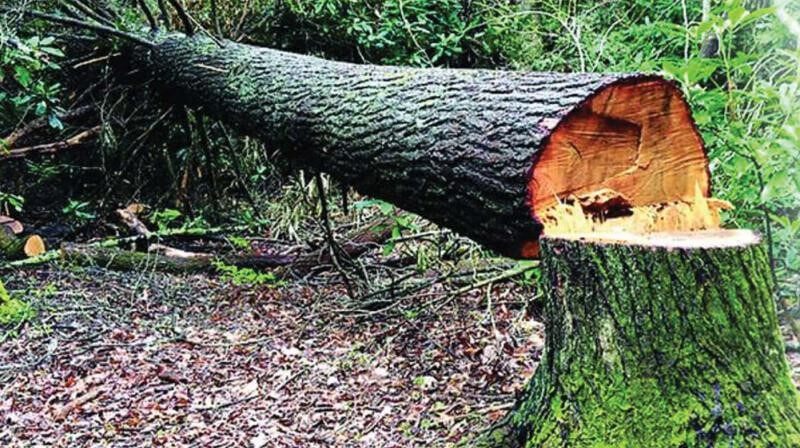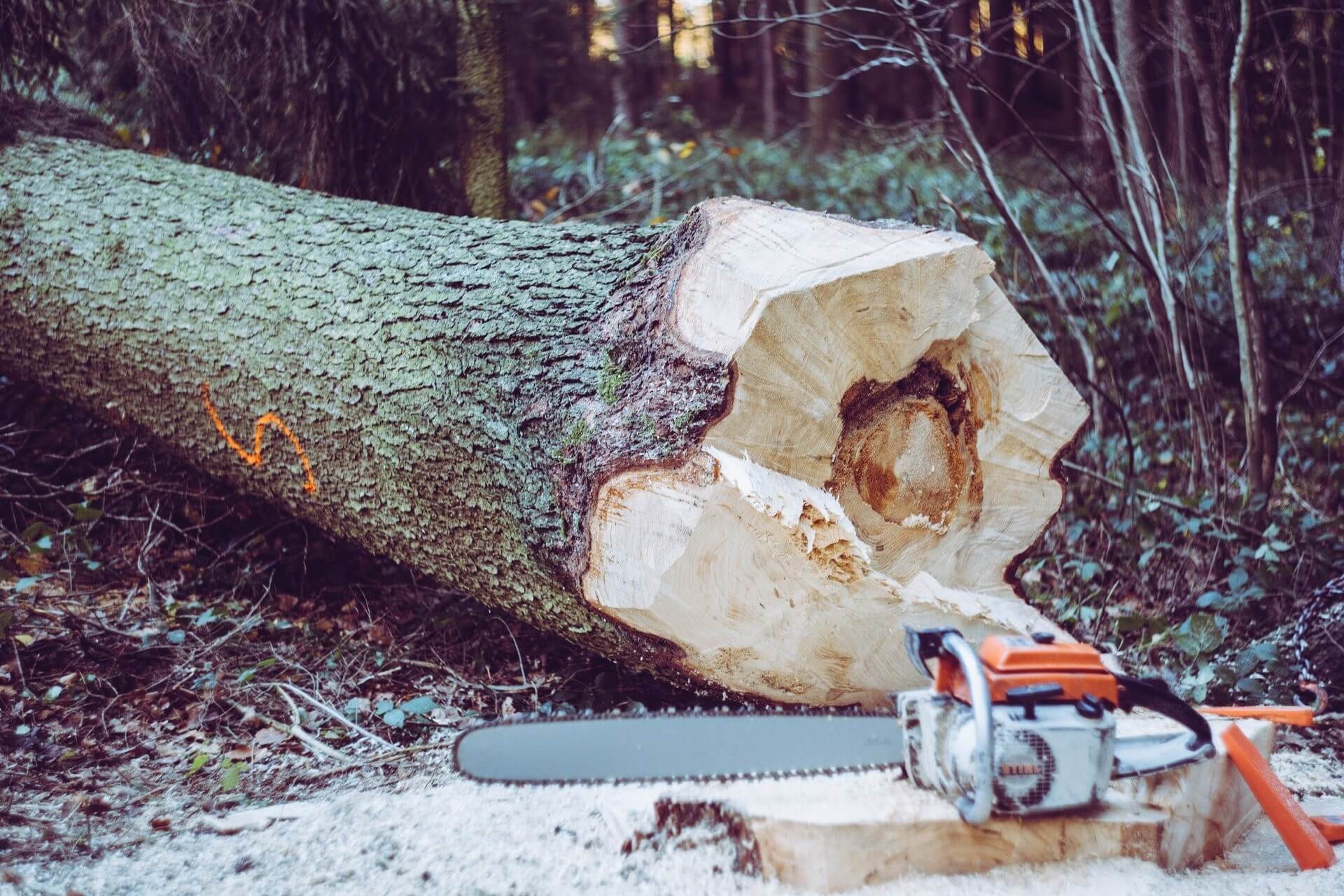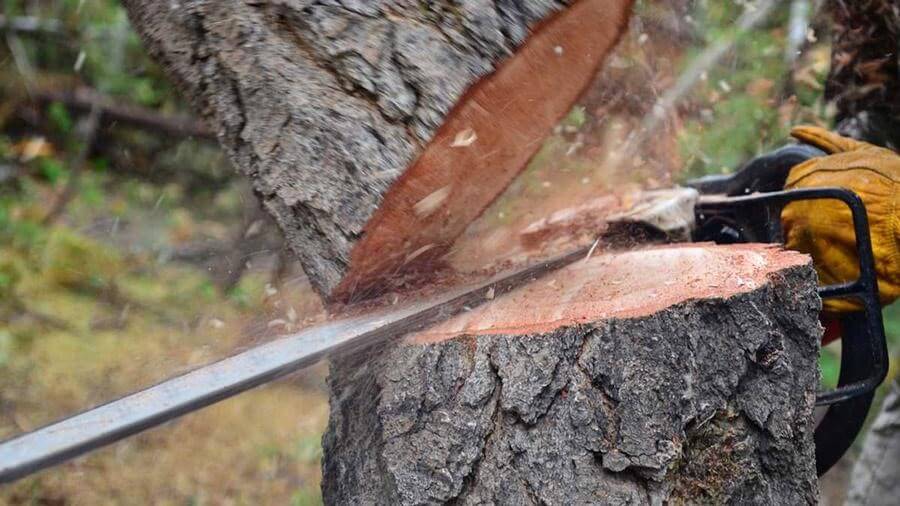It’s great to have trees around, but sometimes they can grow too much or in the wrong places, like too close to your house. This is when you need to think about how to cut down a large tree in sections.
The first step is to look at the tree carefully. Is it really too big? Is it a danger to your house or nearby areas? Answering these questions will help you decide if cutting the tree is the right choice.
It’s important to do this step by step to keep everyone safe and to make sure you’re only cutting down a tree when it’s really necessary.
Before you start, make sure you have the right safety gear. This includes a hard hat, safety glasses, gloves, and strong boots. It’s also important to check your tools and know how to use them safely.
In the next parts of this guide, we’ll talk more about these safety steps.
Identifying Potential Hazards Before Cutting Down a Large Tree
Before you start cutting down a large tree in sections, it’s important to think about safety, especially if the tree is very tall. Big trees can be dangerous, especially during bad weather like heavy winds or rain.
They can fall unexpectedly and cause serious damage or even injury. To prevent this, make sure you check the weather forecast before you start.
Also, look at the tree itself. Are there any dead branches or other signs that it might not be stable? Identifying these hazards early can help you plan how to cut down the tree safely.
Once you decide that cutting down a large tree in sections is the solution, the next step is planning how to do it safely and effectively. This isn’t a simple task, especially for big, widespread trees. You need a clear plan.
Start by figuring out which sections of the tree to cut first. It’s usually best to start from the top and work your way down. This reduces the risk of large sections falling unpredictably.
Also, plan how you’ll cut each section, thinking about where each piece will fall. This step-by-step approach helps ensure safety and efficiency in the tree-cutting process.
The key to safely cutting down a large tree in sections is using the right techniques and tools. You can’t just start cutting randomly. Instead, use a systematic method. Here’s how:
- Choose the Right Tools: A chainsaw is essential. Make sure it’s sharp and in good working order. You’ll also need safety gear like a helmet, gloves, and goggles.
- Start at the Top: Begin by cutting the smaller branches at the top of the tree. This makes it easier to manage and reduces the weight as you work your way down.
- Sectional Cutting: Plan each cut carefully. Make a small notch in the direction you want the tree section to fall. Then, make a larger cut from the other side to meet the notch. This helps control the direction of the fall.
- Stay Alert: Always be aware of your surroundings and have a clear escape path. Never turn your back on a falling tree section.
When you’re ready to start cutting down a large tree in sections, remember that safety is your number one priority. Here are some important tips to keep in mind:
- Work Slowly and Steadily: Rushing can lead to mistakes. Take your time with each cut to ensure you’re doing it safely.
- Avoid Forceful Cutting: Don’t try to force the chainsaw through the wood. Let the tool do the work. Forcing the chainsaw can cause kickback or loss of control.
- Be Mindful of Tree Stability: As you remove sections, the tree’s balance will change. Regularly assess the stability of the tree to avoid unexpected falls.
- Have a Spotter: If possible, work with a partner who can keep an eye on the tree’s movement and alert you to any dangers.
By keeping these safety tips in mind, you can reduce the risk of accidents and ensure a safer process for cutting down a large tree in sections.
Steps to Cut Down a Tree in Segments

As you approach the end of the task of cutting down a large tree in sections, there are several important steps to ensure a thorough and responsible completion:
- Inspecting the Remaining Trunk: After removing the larger sections, examine the remaining trunk. If it’s still significant, it might require further cutting into smaller, more manageable pieces. Approach this with the same careful planning and safety considerations as before.
- Methodical Cleanup Process: The cleanup process is crucial. Start by removing the larger pieces of the tree. These can be cut into logs for firewood, provided to local woodworkers, or disposed of according to local regulations. Smaller branches and leaves should be gathered and can often be used for composting or as garden mulch.
- Site Restoration: Cutting down a tree can impact the surrounding area. After removing the debris, assess the site for any damages to the soil or nearby plants. If the ground has been compacted by heavy equipment or foot traffic, consider aerating it to promote healthy regrowth of grass or other vegetation.
- Evaluating Environmental Impact: Take a moment to reflect on the environmental impact of removing the tree. Consider planting a new tree in a more suitable location as a way to contribute positively to your local ecosystem.
- Future Tree Management Plans: Finally, use this experience to plan for future tree management in your area. Regularly inspect other trees for safety, consider professional pruning, and always prioritize the health and well-being of your green space.
By following these comprehensive steps, you not only ensure the safe and efficient completion of cutting down a large tree in sections but also contribute to the ongoing health and safety of your environment.
Instruments Required for Cutting Down a Tree in Segments

Now you are ready to take action. Keep your instruments required for cutting ready. The instruments that you will need to cut down the tree are:
- A hard cap
- Safety glasses
- Work gloves
- A chainsaw
- Felling wedges
- Hearing protection
- Iron holdings
These together are the equipment that will help us to cut the tree into segments effectively and comfortably.
Get the above safety pieces of equipment from the below-mentioned links.
A Hard Cap
- LARGE SIZE HARD HAT: This large hardhat is is designed for those do not fit into the standard sized...
- MULTI-PURPOSE CAP STRENGTH: Crafted with a phenolic shell and handmade for durability, toughness and...
- FAS-TRAC III SUSPENSION: Designed based on opinions and input from hundreds of customers, our...
- HIGH QUALITY PROTECTION: Intended for general purpose use or in places elevated temperatures. These...
Safety Glasses
- Anti-Fog Safety Glasses: Great goggles for lab workers, no worry about reducing your work efficiency...
- Why Need Safety Glasses? - Eye injuries often occur in the workplace and home in daily life. When...
- Stylish Design, Light-Weight for Ultimate Fit and Comfort: Suitable for teens men or women, The body...
- Fit Over Prescription Glasses Perfectly: Large nose pad design, perfect fit without the slipping,...
Chain Saw
- Cordless chainsaw comes with low kick back 12-inch bar and chain for construction and outdoor...
- Compact, lightweight design (just 9 lbs. with battery) of the battery chainsaw for maximum user...
- High-efficiency brushless motor of the battery powered chainsaw maximizes runtime and motor life
- Up to 90 cuts per charge on 4x4 pressure treated wood (using a 20V MAX* 5Ah battery)
Felling Wedges
- Protect Yourself and Your Employees - Help the tree fall in the safest direction of the notch cut by...
- Protects Chainsaw Accessories - Preventing the weight of tree from pinching chainsaw bar and chain...
- Effective Tree Wedges - Smooth on one side, serrated barbs on other side to easily hold wedge in...
- Durable and Reliable - Constructed of high impact ABS plastic which means that it is highly stable...
Hearing Protection
- CUSTOM MOLDED EARPLUGS: Easily and quickly fitted to the exact shape of your ear. This creates a...
- EASY SHAPE SYSTEM: Simply heat the Decibullz thermoplastic molds in boiling water, let them cool for...
- PERFECT FOR ANY SITUATION: Decibullz are perfect for shooting, traveling, working, loud concerts,...
- INCLUDED WITH PURCHASE: Two Decibullz Thermoplastic Custom Molds, Three Sets of Triple Flange Tips...
Iron Holdings
- Anti-wrap Design: 360 degree free rotation stainless steel ring ensures strength and hardness. At...
- Sturdy Design: The high-quality aluminum alloy ring body and stainless steel ring design make the...
- Adjustable Screw: Use 2 screws to adjust the diameter of flagpole ring. The long screw is suitable...
- Hook Design: 2 pack aluminum mounting rings and 2 piece aluminum hooks for you. You can link the...
Get an Expert’s Help

Sometimes we have equipment and knowledge regarding how to cut down a tree, but we fail to practically imply it. Even if we try, still we fear creating some mess. In such situations, it is always advisable to take help from experts.
Various firms are working especially to cut down trees in sections or as desired by the client. So, it is often advisable to take assistance from these firms to avoid any further major mishaps.
Appointing firms to cut down the trees, can solve and ease the process for you. Your involvement would not be required and hence you remain secured and safe.
But again, choosing what way to cut down a tree again depends on the person’s personal choice and comfort so choose accordingly.
Mess Clearing after Cutting Down a Tree
After getting your desired tree cut the next thing that bothers are the clearance of the mess after the cutting of the tree. We cannot just leave the mess around and walk away. We must settle the mess at the needed place. So, what do we do actually? Just throw it. No.
The smaller branches of the trees if are safe can be used as firewood during your bonfire session. Smaller branches can also be colored and used as an artifact. You can also use those woods in making furniture.
Once the tree is cut and if you have not decided what to do with it then tie the pieces of the trees or the branches and get it settled near somewhere nearby. This will clear your mess after cutting down the tree.
Later you can sell them, modify, and use them or burn them in a bonfire that again goes better as per your comfort and choice.
Conclusion
As we conclude this guide on how to cut down a large tree in sections, it’s important to reflect on our relationship with trees. Trees are vital to our environment and well-being. They provide oxygen, improve air quality, and enhance our surroundings.
However, there are times when cutting down a tree is necessary for safety reasons or to prevent property damage.
This guide aims to provide you with the knowledge to tackle this task responsibly and safely. Remember, cutting down a tree should always be a last resort.
Whenever possible, it’s better to seek alternatives, like pruning or professional advice. If removal is the only option, doing it safely and methodically is key.
We hope this article has been a helpful guide and encourages safe and thoughtful approaches to handling trees in your environment.
Always prioritize safety, plan meticulously, and respect the significant role trees play in our lives.







